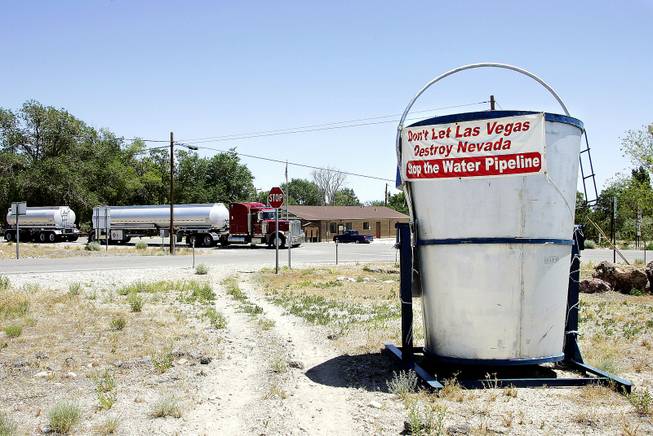
SAM MORRIS / LAS VEGAS SUN FILE
Rural counties’ opposition to the Southern Nevada Water Authority’s pipeline plan has been strong for many years, as this sign in Baker in 2007 shows.
Thursday, May 21, 2020 | 11:13 a.m.
The Southern Nevada Water Authority is retiring a controversial, decades-old proposal to pump groundwater from rural Nevada to Las Vegas and will instead focus on water conservation measures and the pursuit of possible partnerships with other Colorado River water users.
The water authority’s Board of Directors unanimously voted today to withdraw all pending groundwater importation applications, return a right-of-way associated with groundwater importation plans to the Bureau of Land Management and take other actions to move the multibillion-dollar groundwater development project — sometimes referred to as the water pipeline project — into “indefinite deferred status.”
The decision is a win for environmentalists, ranchers, Native American tribes and other stakeholders mostly in Eastern Nevada who have opposed the water authority’s intention to pump groundwater from White Pine, Lincoln and rural Clark counties to Las Vegas through buried pipelines. Opponents said the pipelines would harm the ecology of the region, adversely impact sites considered sacred to some Native American tribes, hurt ranching and worsen dust issues in Utah.
“This is a complete victory for rural and urban Nevada,” said Kyle Roerink, executive director of Great Basin Water Network. “Vegas ratepayers will save billions of dollars, and the Great Basin’s aquifers will retain billions of gallons of water.”
The network is one of many entities that challenged the water authority’s groundwater development project in court for more than a decade. Others include: the Confederated Tribes of the Goshute in Eastern Nevada, White Pine County, Utah’s Juab and Millard counties near the Nevada border, and the Church of Jesus Christ of Latter-Day Saints.
In March, the Seventh Judicial District Court in White Pine County ruled against the water authority’s groundwater applications in four valleys in Eastern Nevada. The court also rejected the water authority’s proposed mitigation plans to offset unintended consequences of the groundwater development project, calling them arbitrary, unspecific and lacking in supporting evidence.
The ruling and the water authority’s decision not to appeal it appeared to signal the end of the 30-year fight. But the water authority still had some groundwater applications pending, worth more than 50 billion gallons of groundwater per year, as well as an associated right-of-way application with the BLM, Roerink said.
With the water authority having agreed to give those up, the fight is finally over, he said.
“This is everything we wanted. We’re ecstatic,” Roerink said.
The groundwater development project was devised in 1989 when the water authority feared its water allocation from Lake Mead and the area’s limited groundwater resources were insufficient to support rapid growth in the valley. But over the years, the water authority developed a series of conservation measures for residential and commercial customers, including restrictions on outdoor watering and turf removal programs, that significantly reduced per capita water use.
“I’d say the architects of the groundwater projects were well-intentioned. They understandably wanted to ensure that Southern Nevada has long-term access to water given that our Colorado River allocation is insufficient,” said Justin Jones, a Clark County Commissioner and board member. “But over the course of the past 30 years, it has become clear the project doesn’t make sense either environmentally or economically.”
In addition, the water authority completed a low lake level pumping station at Lake Mead this year that ensures the valley will have access to the lake’s water even during times of severe drought. These measures are ultimately more cost-effective for the water authority than the groundwater development project, said John Entsminger, general manager of the water authority.
“This community’s recent conservation achievements and the completion of the Low Lake Level Pumping Station last month ensures we can meet our community’s projected water demands for decades to come, even with Lake Mead’s ongoing water level fluctuations,” Entsminger said in a statement.
The water authority is now considering investing in a water recycling program in Southern California as well as the option of desalination, or the removal of salt from saltwater, to increase water resources. Earlier this year, the board’s Integrated Resource Planning Advisory Committee recommended that the water authority focus exclusively on those goals as well as enhanced conservation plans.
The board will consider advisory committee's recommendations in the coming months as it develops its 50-year water resource plan. The plan will reflect the decision to move the groundwater importation project into deferred status, the water authority said in a statement.
